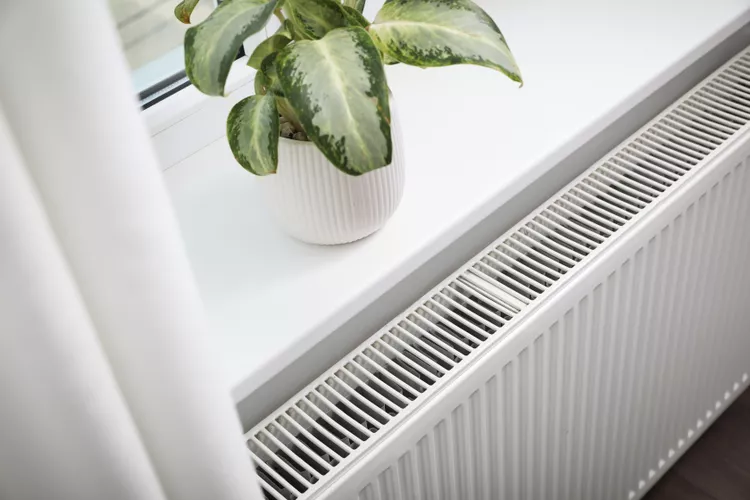6 Types of Heating Systems and How to Choose One for Your Home
Different types of heating systems have unique advantages and disadvantages that could cause them to work better or worse in certain settings. Homeowners must consider efficiency, maintenance requirements, performance, and cost when choosing the best heating system.
We’ve presented several popular heating system options, explained their pros and cons, and outlined what each is best suited for to help you decide which heating system is right for your home.

Forced Air Furnace
Forced air furnaces are one of the most common heating systems in today’s homes. Although there are different types of furnaces, they all work in the same general manner. A furnace heats the air that is then blown through ductwork into a living space, which results in almost immediately heated air. Modern, properly installed forced air furnaces can be extremely energy-efficient heating options. On average, a new forced air furnace costs $4,735.
Pros
- Relatively low maintenance
- Uses the same ductwork as the AC system
- Quickly heats the interior
Cons
- Possible inefficiencies due to compromised ductwork
- Can be noisy
- Can cause dry air
Heat Pump
Heat pump systems extract warmth from air, water, or subsoil, and then distribute it within the home. Most basic home heat pumps are air-source heat pumps, which use the outside air to extract heat, even on the coldest days. Heat pumps are highly energy-efficient heating systems, as they rely on electricity mostly to move the heat rather than create it. Heat pump installation cost averages slightly higher than a forced air furnace at $5,500.
Pros
- Energy-efficient
- Combined heating and cooling system
- Even heating
- Low maintenance
Cons
- High upfront cost, though tax rebates may be available
- Might require supplemental heating in colder climates
Hybrid Heat System
Hybrid heat systems combine furnaces and heat pumps, giving you the best of both worlds. When temperatures are mild, the heat pump is solely responsible for keeping the home comfortable. However, the thermostat can be programmed to kick on the furnace when temperatures dip below a certain threshold, ensuring your home never gets too cold while maximizing efficiency. These hybrid systems often have an upfront cost that can reach $10,000.
Pros
- Highly energy-efficient
- Requires little input from the homeowner
- Enables homeowners to use heat pumps even in cold climates
Cons
- Not as low-maintenance as some other options
- More components equate to a higher price
Boiler
Boilers function exactly how you think—by boiling water. The hot water (or steam, depending on the system) then circulates through the house in a variety of ways, such as through radiators, where the heat naturally gravitates toward the cooler air. The water is heated by several optional fuel sources, including natural gas, liquid propane, and electricity. The most noteworthy cost associated with boiler systems is the price of replacing the major components like boilers and radiators, which can exceed $8,000.
Pros
- Less dry air than other heating options
- Modern baseboard radiators are available
Cons
- Radiators aren’t visually appealing
- Radiators take up interior square footage
- Air conditioning system must be installed separately
Radiant Heat
Radiant heat systems typically refer to in-floor heating systems. These systems evenly distribute heat throughout a home’s flooring, which radiates it through the living space. This heat is transferred in the form of hot water circulated through a series of tubes integrated into the subfloor. Radiant in-floor heat systems aren’t cheap. A whole-home installation could cost as much as $48,000.
Pros
- Evenly distributed heat
- Doesn’t spread allergens
- Very low maintenance when installed properly
- Silent operation
Cons
- Not ideal for extremely cold climates or those with frequent temperature fluctuations
- Must be installed before flooring
- Expensive
Wood Burner
Wood burners are an age-old heating method often chosen for its economical approach. Wood is generally less expensive than other fuel sources such as natural gas, liquid propane, and electricity. This is especially true if you harvest it yourself from your property. Many people choose fireplaces or wood stoves as supplemental heat.
The natural tradeoff is that wood-burning heat systems are very hands-on. A lot of labor goes into harvesting and preparing the wood, feeding the burner, and keeping the system clean. For installation, expect to pay less than $500, depending on the system you choose.
Pros
- Great for rural areas
- Relatively inexpensive fuel source
- Doesn’t rely on a power source
- Modern stoves are energy-efficient
Cons
- Can be labor intensive
- Poses health risks if installed or operated incorrectly
- Doesn’t circulate heat efficiently
- Hands-on operation and maintenance
Which Heating System Is Right for Your Home?
To determine which heating system is right for you, use this list to weigh each system against your home’s needs and your budget. Remember, a heating system that’s more expensive upfront may save you immensely more in the long run, as it is much more energy-efficient. Consider your region’s climate, your home’s insulation quality, the size of your home, the layout, and any other factors that could affect a given heating system’s ability to perform.
When in doubt, consult with your local HVAC professionals. They’ll be able to help you narrow down which heating systems are most popular and cost-effective in your specific region.
